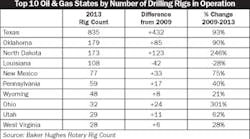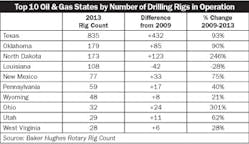It’s no secret the oil and gas business is booming — just ask anyone you know from Texas, Oklahoma, North Dakota, Pennsylvania and Ohio. Many of the folks we talked to from these states at recent electrical industry meetings are delighted with the huge uptick in the oil and gas market, which is due in large part to the newer oil fracking and horizontal drilling technologies that have unlocked oil and gas plays that previously couldn’t be profitably harvested.
There’s no better indicator for how fast this new oil and gas business hit these markets than the weekly rotary rig counts published by Baker Hughes since 1944. As the company says on its web-site, “When drilling rigs are active they consume products and services produced by the oil service industry. The active rig count acts as a leading indicator of demand for products used in drilling, completing, producing and processing hydrocarbons.”
These Baker Hughes rig counts document the good times and the bad in the oil and gas industry, and as anyone in this business can tell you, times are usually either very, very good or stand-on-a-window ledge bad. The number of rigs has increased dramatically in two of the larger oil and gas plays in the United States, North Dakota’s Bakken and Texas’ Eagle Ford. With a 246% boost in the number of rigs at work in 2013 compared to 2009, North Dakota saw the most dramatic increase, jumping from 50 rigs in operation in 2009 to 173 rigs working in 2009 in 2013.
Texas has a long history of dramatic increases and declines in its rig count, and the 432 additional rigs it now has working compared to 2009 compute to a 93% increase. But the state has seen business swing the other way, too. According to Baker Hughes’ data, between 2008 and 2009, Texas saw a huge decline, when its rig count dropped from 898 to 432 — a bigger decline in one year (466) than it enjoyed in the most recent run-up. A 2009 Wall Street Journal article said a crash in oil prices from about $145 per barrel in 2008 to $45 per barrel in early 2009 lead to the 2009 layoffs of thousands of oil workers in Texas and around the world, including 1,500 by Baker Hughes, 5,000 by Schlumberger and 1,350 by Conoco Phillips.
It’s tough to put a number on exactly how much this new petro business impacts the sale of electrical products, although there’s little doubt it has been a boost for sales of hazardous locations electrical equipment such as boxes, enclosures, fittings and lighting fixtures for drilling sites and refineries, as well as commercial/industrial products for the related businesses that support the work in the oil and gas fields, like restaurants, housing, gas stations and other retail/commercial construction.
One indicator offering some insight into the impact the Bakken play has had on the North Dakota electrical market is the number of electricians working in the state. According to U.S. Bureau of Labor Statistics’ data on electrician employment, from 2008 (before the oil and gas boom) to 2012, North Dakota gained 680 electricians. With Electrical Wholesaling’s estimate of $66,6627 in buying potential for each working electrician, you have a 35% increase in North Dakota’s sales potential for electrical contractors to $173.2 million — a $45.4 million increase. Not all of this increase can be attributed to the growth of the state’s oil and gas industry, but it’s got to be a major contributing factor.
Electrical manufacturers are positioning themselves accordingly for this burst in business. When Emerson bought back the 44.5% interest that SPX had in its EGS Electrical Group (now known as the Appleton Group), the company said the move would allow it to concentrate on “emerging growth opportunities in the oil, gas and petrochemical industries” (see EM — Jan. 10).
Some electrical distributors have moved aggressively to expand their operations in the oil and gas industry by opening up new branches or expanding existing facilities to service the Bakken, Eagle Ford and Marcellus regions. In fact, according to EM’s new branch database, of the more than 30 new branches distributors either opened or expanded since 2011, more than 20 are in one of these regions. Elliott Electric Supply, Nacogdoches, Texas, and Graybar, St. Louis, have opened or expanded the most branches in these areas over the past three years.
Elliott Electric has more than a dozen new or renovated locations serving the petro markets in Texas and Oklahoma, and Graybar has at least five new branches serving the oil business in Dickinson and Minot, N.D.; Williamsport, Pa.; Binghamton, N.Y.; and Carrizo Spring, Texas.
Other distributors with new locations in these areas include Crescent Electric Supply (Sidney, Mont).; Consolidated Electrical Distributors (Dickinson and Williston, N.D.; QED Inc. (Dickinson, N.D.); Border States (Midland, Texas); Houston Wire & Cable (Odessa, Texas); Summit Electric Supply, (Pearsall, Texas); and W.W. Grainger (Williston).










